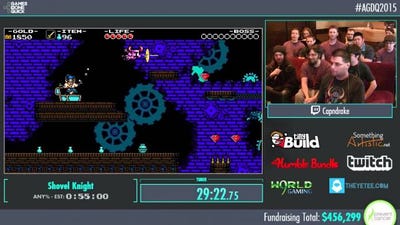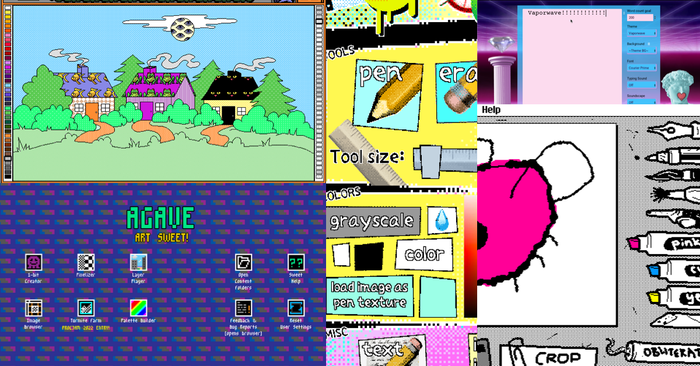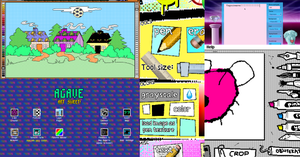The makers of Spelunky, Shovel Knight, Crypt of the Necrodancer, and Axiom Verge share tips on how to design gameplay features that are catnip to the speedrunning community.

Speedrunning is extremely popular now, as popular streams and videos on Twitch, Youtube, and at events like Games Done Quick readily attest. But in a way, it’s always been popular.
Record-setting runs on games like The Legend of Zelda or Double Dragon are as old as consoles and arcades themselves, and games like Metroid famously rewarded fast playthroughs with specialized endings.
But in 2016, speedrunning isn’t just about handful of elite players jockeying for position in the record books. It’s a style of play that many enjoy, and it's the cornerstone of many burgeoning communities. Players compete with each other for high scores and fast run-throughs, but they’re also developing strategies, socializing, and organizing around these specialized playthroughs, all while audiences watch for the joy and thrill of crazily high-skilled gameplay.
So if you’re developing a game with speedrunners in mind, what are some of the best practices for your development cycle? We talked to developers Derek Yu, Thomas Happ, David D’Angelo and Ryan Clark, whose games all make frequent appearances at speedrunning events, to learn some of their observations after watching players blaze through their game.
1) Involve Speedrunners Early
If you’re making a game you think will be of special interest to speedrunners, why not make them some of your first playtesters? David D’Angelo, a developer on Shovel Knight, explains that having speedrunners test your game out first gives you some clear advantages.
Says D’Angelo, “We had made a bunch of games together at Wayforward and we kept seeing speedrunners play our games, and we said 'I wish we had that feedback before we shipped out a game.’ D’Angelo says their new speedrunning friends automatically climb the skill curve of a game and begin hitting the flow interruptions of a given level much faster than they or normal testers would, whether it's a bug or just a flaw in platforming design.
In one Shovel Knight example, speedrunners found flaws in D’Angelo’s timing for moving platforms in a room, sometimes pointing out there was literally no perfect way to move through a space, since platforms wouldn’t be ready after they easily cleared some earlier obstacle.
Since speedrunners rely on the ability to move as quickly as possible through a given space, there was no way to ‘cheat’ some of Shovel Knight’s levels, and D’Angelo and his team had to make regular calls as to which levels needed a flow improvement, and which ones were intentionally difficult.
 One quick sign that a speedrunner has found a big flaw in your game, according to D’Angelo, is if they reset to the main menu and load back in rather than face an obstacle.
One quick sign that a speedrunner has found a big flaw in your game, according to D’Angelo, is if they reset to the main menu and load back in rather than face an obstacle.
One example of this arose with the game's wandering encounters--enemies who were programmed to randomly appear on the map with no easy predictability.
D'Angelo and his team saw that speedrunners would load back out, then back in, rather then deal with a randomly spawning enemy. “We thought 'that's really boring to play, and really boring to watch.' So we put in a rule: if you're beating the game at a certain speed, the wandering encounters don't show up any more.”
2) Spearhead the Speedrunning Community Yourself!
For Ryan Clark's Crypt of the Necrodancer, speedrunning started as soon as the game hit Early Access. Clark himself began making record-breaking runs on the game with his newfound community and commentating on Early Access speedrunning tournaments.
.jpg/?width=400&auto=webp&quality=80&disable=upscale) Though this early speedrunning would contribute to some major design decisions, Clark indicates that this community outreach was the foundation for a specific fanbase that would stick around with his game after it officially launched, as the “Balls of Steel” tournament series gave way to the CONDOR speedrunning league. (Crypt Of the Necrodancer Online Racing).
Though this early speedrunning would contribute to some major design decisions, Clark indicates that this community outreach was the foundation for a specific fanbase that would stick around with his game after it officially launched, as the “Balls of Steel” tournament series gave way to the CONDOR speedrunning league. (Crypt Of the Necrodancer Online Racing).
And Clark himself just finds that speedrunning, especially for a procedurally generated game, is a good way to test his own bugs and design. “I enjoy speedrunning games myself," he says. "Whenever I was testing something, I was going as fast as I could because I enjoyed that.”
3) Accommodate Low-Power Playthroughs
Clark’s biggest lesson from watching those Early Access speedrunners was one about how to define a speedrunner as a player type.
In a platformer or any general action game, a speedrunner is going to be the sort of player who avoids most sidequests or hidden objectives, and will therefore have the lowest amount of health and desire o deal the highest amount of damage. Designing features for those players becomes an exercise in learning what systems in your game will work best for them.
“There were a bunch of items in the game speedrunners were disappointed to get,” says Clark. These items were Necrodancer’s gold weapons and blood weapons—which respectively rewarded players with gold and health, the two things speedrunners don’t need—and they quickly told Clark they were disappointing items.
Clark changed the items not so they’d deal more damage, but that they’d deal more damage in specific circumstances.
Gold weapons will do maximum damage after landing on a pile of gold, and blood weapons will do maximum damage while the player is sitting at the lowest possible health they can have. “If you’re willing to play very risky, and be on the edge of death at all times, you can go super fast," he says. "We made a bunch of changes to items and things like that to make as many as possible be speedrun as possible.”

This same concept applied to Thomas Happ’s work on Axiom Verge. While watching speedrunners play his game, and commentating on a few sessions, Happ says he realized enemies that he’d considered to be minor obstacles could become major ones in the face of those players who never picked up any hidden health packs. “The way you test that is to go through the game with an underpowered build, not to be as fast as a speedrunner but to see how it affects them,” Happ says. “This will help you understand exactly where an enemy is much harder if you don't have your power-ups."
4) Festoon Your Game With Arcane Knowledge and Hidden Secrets
Of all the games popular in the speedrunning community, the one most infamous for its hidden depths and incomplete knowledge may be Derek Yu’s Spelunky. It's procedural generation proved to be so complex that players literally spent years finding hidden levels and searching the furthest depths of the game.
Yu takes pride in his game’s procedural generation for helping keep it fun over the years, but he also firmly believes that deeply hidden mechanical secrets can help provide long-term value. “One thing I've learned is that a secret can never be hidden so well that someone won't figure it out much sooner than you anticipated,” he says. “I won't hesitate to bury something deep if I feel like it!”
.jpg/?width=400&auto=webp&quality=80&disable=upscale) This helps create systems where players begin to adopt different strategies for accomplishing their run. By burying shortcuts, object combinations, and power boosts as deep in the game’s system as you can, (sometimes through random generation), you can create scenarios where players endlessly research and dig through your game, sharing knowledge with each other even as they constantly compete.
This helps create systems where players begin to adopt different strategies for accomplishing their run. By burying shortcuts, object combinations, and power boosts as deep in the game’s system as you can, (sometimes through random generation), you can create scenarios where players endlessly research and dig through your game, sharing knowledge with each other even as they constantly compete.
In Necrodancer, Clark says that a mistake in his procedural generation led to the creation of a valuable secret startegy. "In Zone 1, the exit's always down, or to the right, or down and to the right," Clark explains. "I didn't intend to do that, I screwed up the programming and players figured out if rooms are connected like this, it's probably down and to the right.”
“With that first zone, it was an accident that you could tell where the exit was," he says. "In the 2nd/3rd/4th zones, I tried to make it do them more on purpose. I've watched people try to test these things out, and it feels like a eureka moment for them when they do figure it out and feel really awesome about themselves because they just intuited something about the game.”
Clark says moments like this will see speedrun commentators join in on the action, as they observe player strategies and make predictions about what might happen, helping make a playthorugh more entertaining for runner and spectaors simultaneously.
5) Embrace Mistakes...and Turn Them Into Mechanics
There’s one inescapable fact about speedrunning: Most of the time, speedrunning is about breaking the game and making use of flaws that developers never intended to serve as shortcuts.
Developers have the ability to patch away these bugs. But if a glitch or an exploit draws thousands more players to your game—how do you decide what's a 'bug' and what's a feature?
All of the developers interviewed for this piece made the same point about bugs: only fix it if it interferes with non-speedrunning play. Happ says he has agonized over certain bugs. “You could grapple in a certain place, and you could swing through the wall, and I was worried about players getting into a location they couldn't get out of,” says Happ. “That was the kind of decision that left me on the fence.”
 Yu says that while watching players play Spelunky, one bug proved so essential he had no choice but to turn it into a feature. “We legitimized one exploit that let you break the Moai head with a ball and chain," he says. "It was critical to a number of speed and challenge runs (including the infamous solo eggplant run). We changed the sprite to make it look like it was actually broken.”
Yu says that while watching players play Spelunky, one bug proved so essential he had no choice but to turn it into a feature. “We legitimized one exploit that let you break the Moai head with a ball and chain," he says. "It was critical to a number of speed and challenge runs (including the infamous solo eggplant run). We changed the sprite to make it look like it was actually broken.”
D’Angelo, however, believes a degree of moderation is needed when debating whether to keep major time-saving bugs in the game. “It's cool for speedrunners to play a game in a way that a real person plays it, because that's what makes it look awesome.” he says.
“But when it's finding glitches, and things that are very bizzare, those are cool to see in a separate run. Encouraging the main way to play the game to not be those is what we're trying to solve for.”
Happ has seen players glitch past large portions of his game, and he’s fine with it. It’s a trope in classic side-scrollers like Metroid and Castlevania, and he even felt a sense of relief when he watched a speedrunner break Castlevania: Symphony of the Night for Koji Igarashi during a stream for the Bloodstained Kickstarter. “I was thinking 'Wow, is my game gonna have that? Did I build my game in the right way so people will find things to break I didn't even think of?'
"It turns out they did," he says. “When I had that verification, I went 'my game is speedrunnable.’”
6) A Tip So Obvious That It's Easy To Overlook
If you’re looking for one simple thing to help speedrunners with your game—just add a run-tracking clock. Clark, Happ and Yu all discussed the benefits of an in-game clock to help track runs, and Yu even went so far as to add new HUD elements specialized for speedrunners.
Ultimately, supporting speedrunners is about helping high-skill, high-reflex players achieve faster and faster times without interfering with average players. Keeping that in mind may be the best way to inform your design process.
Involve speedrunners early, consider the type of playstyle they adopt, build in secrets for them to uncover, and be grateful when they find exploits that bypass some of your carefullly designed challenges. Do all of this and who knows? Your game may be the next speedrunning sensation that players are fighting to set records on.
About the Author(s)
You May Also Like








